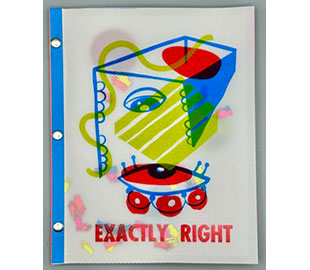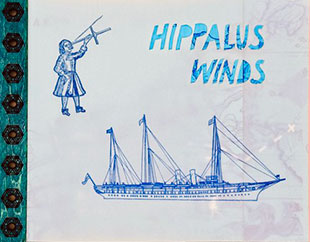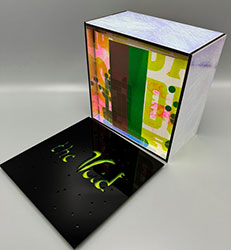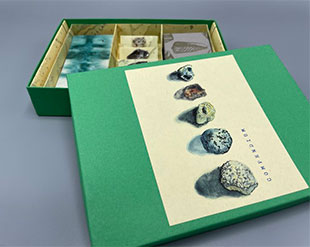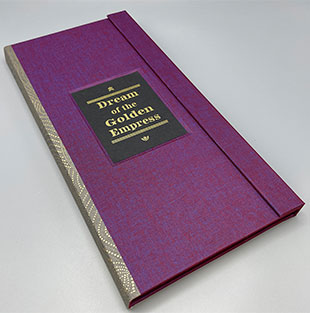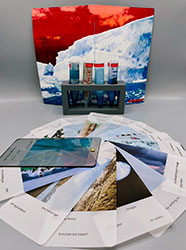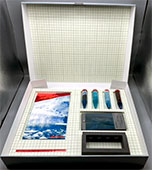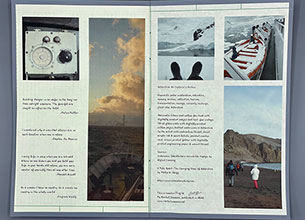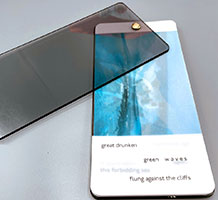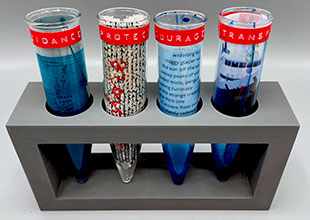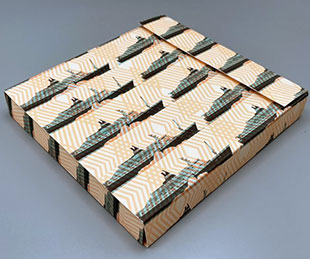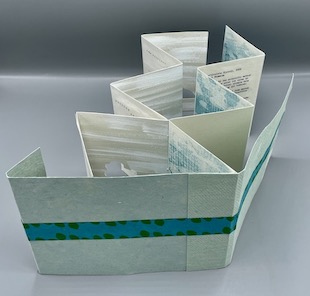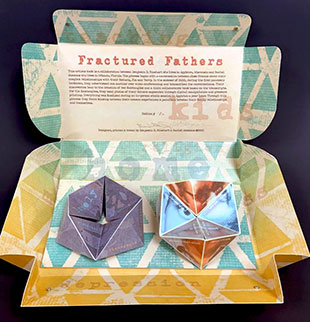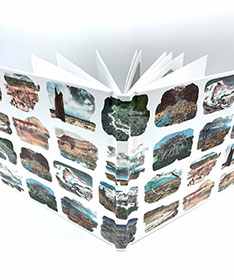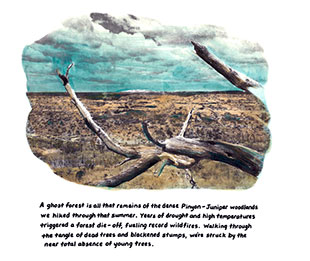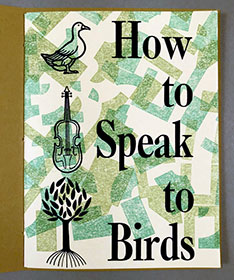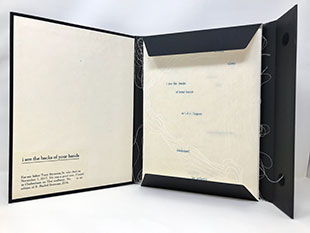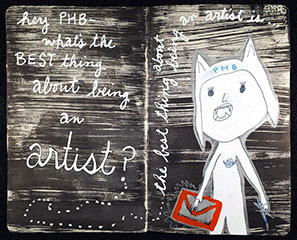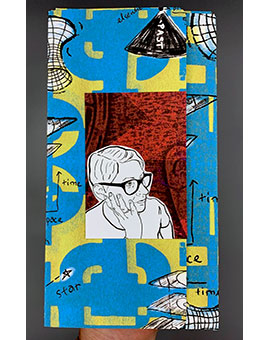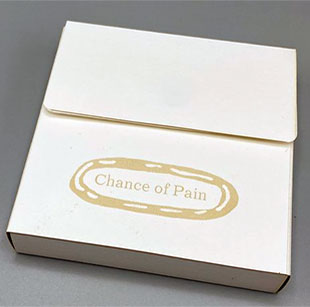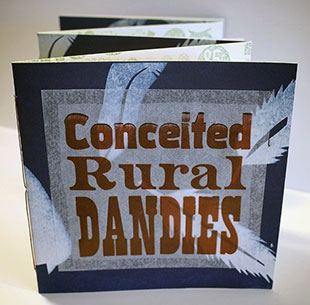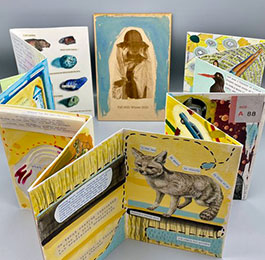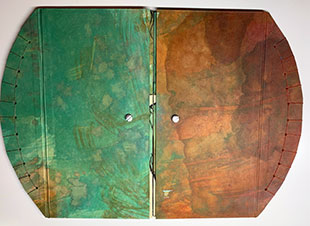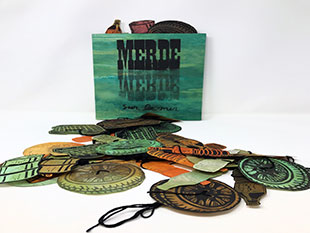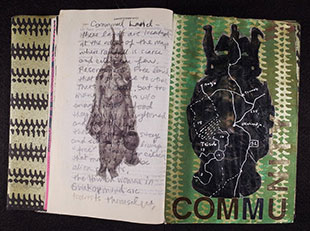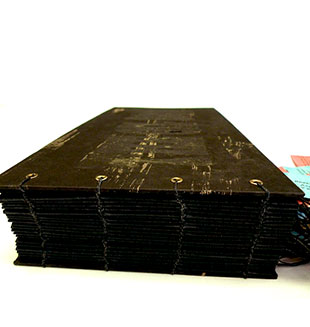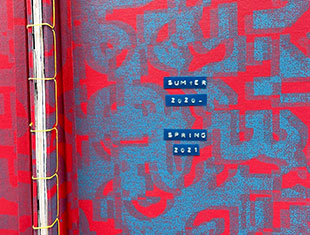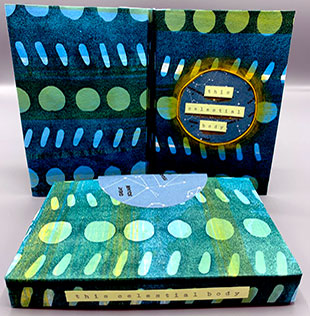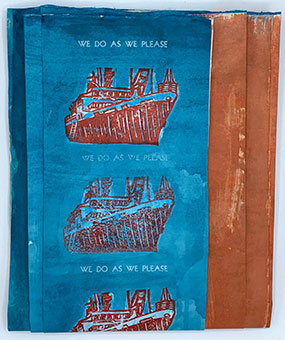
Share this page: |
||
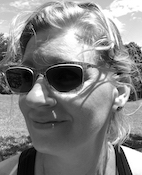 |
Artist's Bio: "Rachel Simmons is an artist-educator who teaches book arts and printmaking at Rollins College. Rachel began teaching there in 2000 after earning her MFA in Painting & Drawing from Louisiana State University. Her diverse practice explores environmental issues, social narratives and personal self-reflection. Many of her books address tensions surrounding globalization, ecotourism, activism, climate change & sustainability. In Rachel’s socially engaged art projects, she asks community participants to think critically and creatively about our relationship with nature." | |
| CBAA artist feature TEDx Talk "Green Art: Art that Makes a Difference", January 2011 |
||
Exactly Right Risograph, screen printing, letterpress, relief, monotype, vinyl, collage and tape on vellum, paper and Braille book pages. Stab bound with metal rivets with organza enclosure, 36 pages. Closed dimensions are 11" x 8.5" x .5" and open dimensions are 11" x 17" x .5" Signed and numbered by the artist. Rachel Simmons: "With pages printed using a range of approaches including Risograph, screen printing and letterpress, ‘Exactly Right’ is a meditation on the labor-intensive process of making an artist's book. Objects that emerge from any creative practice are a product of years of experience, training and labor-ideas that take physical form through a daily commitment to making. Practitioners of book arts have a special relationship with the search for perfection; I tend to fluctuate between seeking and destroying it. In my studio, I always have several different types of projects going simultaneously, some that need careful attention to detail, and others that feel more spontaneity and experimentation. It's this balance between craft and innovation that captures my interest. This variable limited edition artist's book was created one spread at a time over the course of several months. I used available resources and scraps of time in between teaching to puzzle through each page and piece them together into a book. “When I was in college I worked in an office, and when I wasn't answering the phone or filling, I was typing letters and making zines using whatever office supplies were on hand. Some of the materials in this book-sticky notes, craft tape, copier paper-speak to the love of making books with shiny, pretty, but common place materials, while the layered printing and collage show an attention to detail and craft that transforms these materials. The Risograph digital duplicator, while intended for use by schools and businesses as a color copier, has been reclaimed by artists for making zines and prints. In addition to shiny and smooth vinyl and laser-cut collage- found Braille pages provide a tactile experience that reminds all readers about the physical fascination we have with books. “I recorded this artist's talk on ‘Exactly Right for The Book as Art v.12 Rock, Paper, Scissors on October 9, 2024." |
||
Hippalus Winds Stab-bound with risograph prints, paint markers, laser-cut vellum, metal rivets and engraved wood. Signed and numbered by the artist. Rachel Simmons: "Based on classic tales of early ocean exploration and my experiences traveling by ship to Antarctica and around the Galàpagos Islands, ‘Hippalus Winds’ pairs found imagery with excerpts from the fictional diaries of two first-century CE explorers. Stab-bound with metal rivets and engraved wood, the sequence of vividly-colored risograph prints contains fanciful nautical maps crawling with sea monsters and cannibals, and early illustrations of the Earth as a dome-covered disc. The voices of Eudoxus a wealthy Greek privateer, and his navigator Hippalus, who discovered the passage from the Red Sea to India by predicting monsoon winds, alternate between regret and intrigue as they experience stormy seas, visit unknown islands and make new discoveries." |
||
The Void Risograph and digital prints on paper and vellum with typewriter, mirror tape, vinyl and collage. Pamphlet stitch binding with magnetic wrapper cover enclosed in a lidded box constructed from wood, acrylic and mirrored vinyl. Box is 5.5" tall x 5.5" wide x 3" deep. Book is 5" tall x 5" x .25" deep when closed and 5" tall x 13" wide x .25" deep when open. Signed and numbered by the artist. Rachel Simmons: "’The Void’ is a vivid mixture of fluorescent colors, translucent papers, and a range of rough, sanded and mirrored surfaces meant to invite touch. Using the tone of a scientific study, the text invites readers to consider how creativity and imagination bridges gaps between human knowledge and the unknown. ‘The Void’ is a scientific theory about invisible fields that bind the universe together. Referencing disciplines like astrophysics and cognitive science, the book presents abstract imagery, notes and poses questions for the reader about what can be discovered in the unfamiliar to recreate the past and invent the future. “The retro-galactic aesthetic was inspired by my favorite fluorescent fashions, New Wave music and music videos I remember from growing up in the 80's and 90's. By pairing scientific text composed on a script typewriter with bright, abstract and reflective imagery, I hope to engage the reader in examining how sensory memory and creativity work in tandem to fill the Void with new ideas. The book's cover was created by layering imagery from my 2023 artist's book, ‘Dream of the Golden Empress’ and features the dancing figure of the Golden Empress as an embodiment of my imagination." |
||
Compendium Box with blizzard divider. Letterpress with digital prints and typewriter on paper. Includes stones, minerals, and shells collected by the artist. Closed dimensions 5" x 7" x 1". Display dimensions approximately 15" x 10" x 5". Removeable lid. Signed and numbered by the artist. Rachel Simmons: "’Compendium’ contains three main components: stones, shells and minerals from my collection, printed representations of my experiences framed as specimens, and a three-part notebook which poses questions about the compendium's purpose and meaning. “The watercolor illustration on the lid came from sketches of objects I collected (and left behind) at recent residency in Iceland. I printed the letterpress elements at Springtide Press in Tacoma, Washington, using Jessica Spring's incredible collection of plates and ornaments, and in the process, forged a connection between one collector/collection and another. “It was after a bone-chilling plunge into Puget Sound, when we gathered a few interesting pebbles from the shore that I began to examine my life-long habit of picking up rocks and shells. This project was an opportunity to examine this habit in a new light, and to pass objects from my personal collection to other collectors, reframing the purpose of my compendium as a vessel for both individual and collective memories.” |
||
Dream of the Golden Empress Doubled-sided accordion in a hard cover magnetic enclosure with letterpress and screen prints on French and Thai kozo papers, book cloth, and decorative Japanese paper. Closed dimensions are 13.5” tall x 6.75” wide x .78” deep. Open dimensions are 13.5” tall x 16” wide x .5” deep, and for standing display, the dimensions are 13.5” tall x 50” wide x 4” deep. Written, designed and printed by Rachel Simmons. Numbered. Rachel Simmons: "Through cinematic visual language, ‘Dream of the Golden Empress’ tells the story of an arrogant emperor bent on environmental destruction. The characters in this allegory— the Emperor, the Golden Empress and the People— are archetypes referencing actors from the current political landscape in the United States. Like shadow puppets, each character embodies easily recognizable traits like greed, selfishness, compassion, anger and love. The lush color palette of violet, black, gold, emerald green and bright orange alludes to elitist behaviors of excess and unchecked power. Across the book, a linear narrative in fuchsia floats over repeated storm clouds, disrupted by a sequence of five-line protest poems, each multi-layered through pressure printing on wood type. The textural quality of these prints evokes a sense of vibration or disruption, hampering one’s ability to read the message as it glitches. “These two distinct but interwoven threads, the narrative and the poetry, capture two ideas: the historical retelling of a political disaster, and the interruptions caused by cacophonous voices of dissent, warning and protest. The moral of the allegory is revealed in the colophon where readers are asked to take responsibility for their political choices, because despite what fairytales tell us, there are no heroic figures who can save us from ourselves. On the reverse side of the accordion, the Golden Empress is illustrated through Lego relief prints in a style inspired by Balinese shadow puppets. She moves through a series of poses—perhaps dancing or fighting—as befitting her dream to inspire the People to move, respond and take action." |
||
Antarctica: An Explorer's Archive Glass and vellum fan book with digitally printed images and text; four vintage 50 ml glass vials with digitally printed vellum pages, knitted socks worn in Antarctica by the artist with embroidery thread, dried acrylic ink & punch labels; painted wooden rack; screen-printed pamphlet book with digitally printed engineering paper & waxed thread. A) Pamphlet book: Closed dimensions 11.25” tall x 7.18” wide. Open dimensions 11.25” tall x 14”.25” wide. (B) Fan book: Closed dimensions 4” tall x 8” wide x .5” deep. Open dimensions are 15” tall x 15” wide x .5” deep (C) Glass vials in wooden rack: Dimensions are 6” tall x 7.2” wide x 1.4” deep. Optional custom fitted archival display box measuring 17" tall x 20.75" wide x 3" deep. Rachel Simmons: "'Through this personal archive, I engage with concepts of exploration, heroism, gender, storytelling, and memory. There are three distinct physical components in the archive, each referencing an officer’s roles on a typical polar expedition: a scientist’s lab vials, distilling the essentials of exploration; a photographer’s glass book, juxtaposing my experiences with those of early polar explorers; and the ship’s log, written by the captain or navigator, containing a photo essay about the MV Lyubov Orlova, the Soviet-era ship that brought me to the Antarctic Peninsula in 2008, only to be lost at sea a few years later. “The archive’s materials reference the purpose of expeditions— the gathering of data and mapping new areas, the activity of documenting one’s travels through ship’s logs and journals, and the importance of archiving such materials for educational and historic purposes. This interactive archive encourages the reader/viewer to examine the role of the modern ecotourist— a traveler that’s neither scientist nor professional explorer— for whom surviving in the wilderness is an experience they pay to have, rather than work they are paid to do. “Throughout the archive, I incorporate text from Alfred Lansing’s dramatic recounting of the voyage of the Endurance, Ernest Shackleton’s doomed 1914 Antarctic expedition in a wooden ship that was swallowed by ice floes. Lansing’s heroic, gritty, ultra masculine story about how Shackleton’s crew struggled to survive is juxtaposed with my expedition photographs and stories, taken as a woman traveling alone far from home, battling anxiety, seasickness and homesickness, but within the comforts of a cruise ship. Since women were not invited to participate in early polar expeditions, they were excluded from opportunities to become heroic explorers, claim land in their name, inspire grand narratives and secure impressive public personas. As Virginia Woolf wrote, ‘As a woman I have no country. As a woman my country is the whole world.’ In part, my desire to travel to Antarctica was to prove to myself that I could do it, and later, to communicate my experiences to others. “Archives are usually repositories for primary sources and evidence-based materials; however, archives can also document the universal human experience through events in an individual’s life. In this personal archive, I sought to document, revisit and process my Antarctic travel by including pieces of clothing I wore, curating a selection of my photographs, and conducting new research into the origins and disappearance of the Orlova. In many ways, the Orlova was like the Endurance—a floating home that was tragically lost to the sea in service of adventure. As is often the case in my practice, this project was driven by a need to make meaning of events in my life, while communicating aspects of my experiences for the reader/viewer. And, as with any archive, it can be cross-referenced with other archives to provide a more wholistic picture of world events.” $1,650 without box |
|
|
Orlova 6” tall x 6.5” wide x 1” deep closed; 5.75” tall x 16.5” wide x 14” open. Tunnel book construction. Digital printing and letterpress on paper and board. Hard cover with magnetic wrapper box. Includes information page with colophon slipped behind picture on front pastedown. Signed and numbered by the artist. Rachel Simmons: "This tunnel book is named after the MV Lyubov Orlova, a former Russian icebreaker—now a ghost ship—that took me safely to the Antarctic Peninsula in 2008 and again in 2009. I created the scene by making a collage of elements from multiple photographs taken at various times and locations. Like a colorized postcard, this abstraction of a real experience depicts passengers from the Orlova on a zodiac tour of an iceberg bay. In the foreground, one of my cabin mates, a Tasmanian prison guard on holiday, is taking photographs of the landscape. Towards the back of the scene, the Orlova waits patiently for her passengers to return for food, warmth and comfort. The hyper-saturated colors intentionally flatten the space even as the tunnel structure seeks to deepen it, reframing the polar landscape as a theatrical stage and transforming my personal experience as an eco-tourist into a brightly packaged commodity." Colophon: “Named after a glamorous Russian movie star, the MV Lyubov Orlova was a 259 foot long ice-strengthened ship built in 1976 to ferry passengers along the eastern coastline of the Soviet Union. Later in the1990’s, she did a stint as a freight ship, transporting cars from Japan. Eventually she was renovated in 1999 to be used as an Antarctic cruise ship. “I made the Orlova’s acquaintance in 2008 … one hundred passengers … a Romanian computer programmer based in Toronto, a Swiss banker traveling around the globe, a group of Australian backpackers, two sisters from the Midwest, a rowdy Tasmanian prison guard, and a young Ukrainian who jumped into the icy bay in a polka dot bikini for a brisk swim.” |
||
Particulate History Closed dimensions: 12” wide by 6” tall x .25” deep. Open dimensions: 24” wide by 6” tall x 4” deep. Double accordion structure with handmade paper magnetic enclosure. Typewritten text, monotype and relief prints on Thai Kozo paper with gesso, thread and collage. Signed and numbered by the artist. Rachel Simmons: "’Particulate History’, a double accordion featuring polar imagery and visual poetry, was inspired by the scientific method of harvesting historical climate data from the earth’s glaciers by drilling and extracting long frozen cylinders called ice cores. Air pollution, volcanic glass shards, greenhouse gases and industrial chemicals circulate across the planet and become trapped within air bubbles in the ice, preserving samples of the earth’s atmosphere over hundreds and thousands of years. Scientists can travel back in time by studying these layers of frozen time, allowing them to measure and date volcanic eruptions, rising CO2 emissions, temperature fluctuations and even fallout from thermonuclear bombs. I learned about ice cores when researching for my first trip to Antarctica and quickly became fascinated by their physical embodiment of time and knowledge. As I crunched my boots across deep snowfall, I couldn’t help thinking about the history below my feet. "The flexible, tactile structure of the book invites manipulation and presents multiple views based on a reader’s individual exploration. One can peer through cut windows to spy turquoise icebergs or read visual poetry on the mysterious nature of history captured in ice. The work was also influenced by my memories of riding in a zodiac through chunks of ice in the Antarctic Peninsula while hearing glacial ice falling into the bay. The book reads, ‘Glittering white almanac, buckled by pressure, by time, pages floating/flowing, temporarily. A slow metallic crack echoes across the bay.’ The broken textures and aqua color palette evoke the ice, snow, dust and the relentless wind that scours the glaciers. I used found items— plastic carrying bags, ribbon and rubber mesh— to press textures into a Gelli plate to make unique marks in the ink. The six images of the icebergs, also found in my earlier book ‘Tracking B15’, came from photographs I took in a glacial lagoon off the Lemaire Channel." |
|
|
Fractured Fathers Folding container holding two flextangle rings and one pamphlet. Signed and numbered by the artists.
Project Statement: "’Fractured Fathers’ is a collaborative artists book created by Benjamin D. Rinehart from Appleton, Wisconsin and Rachel Simmons from Orlando, Florida. The process began with a conversation between close friends about their complex relationships with their fathers, Jim and Terry. In the summer of 2020, during the first pandemic lockdown, they interviewed one another over video conferencing and transcribed the conversations. “Their discoveries led to the creation of two flextangles and a third collaborative book based on the transcripts. For the flextangles, they used photos of their fathers augmented through digital manipulation and pressure printing. Everything was finalized during an in-person studio session in Appleton a year later. Through this process they found kinship between their common experiences & parallels between their family relationships and themselves." |
|
|
Visible Climate: [Deluxe]: Each copy includes a print-on-demand artists’ book with fold out postcards and a different original mixed media drawing from the “Visible Climate” series. The hardcover drum-leaf bound book is 10” x 8” and the drawings average around 8.5” x 11” in size. Each drawing is unique, and made by hand using photo transfers, watercolor and charcoal pencil. Numbered. Rachel Simmons: "This interdisciplinary project was completed in 2020 by Lee Lines (geographer) and Rachel Simmons (artist), colleagues at Rollins College who have collaborated on environmentally themed visual art projects since 2010. ‘Visible Climate’ is the product of more than 175 hours of field work in our national parks, researching and documenting climate change impacts, followed by a collaborative process of translating visual evidence into an artists’ book to shed light on the impacts of climate change in some of our nation’s most iconic landscapes. “To create the work, Lines’ original digital photographs (and two historical national park images) were reduced to black and white, transferred to Stonehenge paper, hand-colored and then re-digitized by Simmons. This multi-step process created a selective loss of information and degradation, while the hand-colorization references and challenges romanticized landscapes from postcards produced when the parks were first mass marketed to early 20th century visitors. Lines’ handwritten captions — based on his field work in the parks— imagine the voices of park visitors over decades as they encounter changing habitats, receding glaciers, and drought-altered landscapes." “Artist Book Reviews: Visible Climate” by Levi Sherman |
||
Visible Climate: 10 x 9" (25 x 20cm); 22 pages. Digital printing. Hardcover, perfect bound, with illustrated covers. Print on demand book. Rachel Simmons: "This interdisciplinary project was completed in 2020 by Lee Lines (geographer) and Rachel Simmons (artist), colleagues at Rollins College who have collaborated on environmentally themed visual art projects since 2010. 'Visible Climate' is the product of more than 175 hours of field work in our national parks, researching and documenting climate change impacts, followed by a collaborative process of translating visual evidence into an artists' book to shed light on the impacts of climate change in some of our nation’s most iconic landscapes. "To create the work, Lines’ original digital photographs (and two historical national park images) were reduced to black and white, transferred to Stonehenge paper, hand-colored and then re-digitized by Simmons. This multi-step process created a selective loss of information and degradation, while the hand-colorization references and challenges romanticized landscapes from postcards produced when the parks were first mass marketed to early 20th century visitors. Lines’ handwritten captions — based on his field work in the parks— imagine the voices of park visitors over decades as they encounter changing habitats, receding glaciers, and drought-altered landscapes." |
||
How to Speak to Birds 6" x 4.75"; 8 pages. Letterpress printed. Covers cyanotype on paper. Produced in January 2018 at Penland School of Craft, Winter Residency. Numbered. Rachel Simmons: "How to Speak to Birds is a letterpress chapbook I created at Penland's Winter Residency Program, in which I adapted text from a 1940’s publication which introduced birdwatching as a hobby to 'young & old, outdoors-lovers & shut-ins.' Through my adaptation of the text in historical fonts and with engraved illustrations, I am encouraging viewers to relate to nature by considering the physical act of attempting to 'speak' to birds in their own language. This work distills birdwatching down to the simple act of adopting an active awareness of one’s environment, promoting the value of having a quiet mind which learns to listen before speaking. This work is part of the ongoing body of work, 'The Language of Watching'. "The Language of Watching is a multifaceted project began in July 2015 during my time as the Artist-in-Residence at Constellation Studios, an independent community print studio in Lincoln, Nebraska owned and operated by Karen Kunc. The project is informed by my research into the social/political ramifications of bird representations in field guides, the history and culture of birdwatching, and the relationships between birdwatchers and birds, and more broadly speaking, between humans and the natural environment. FLOCK, a socially engaged art project, has evolved since 2015 to include over 200 community participants across the US. In a socially engaged art project, the 'art' is considered to be the interactions between participant-viewers & the artist. In my practice, I often make imagery or objects with participants as a mean to facilitate a shared dialogue about our connections to nature." |
||
i see the backs of your hands 9.125” x 12.125” x .5”; 10 leaves. Unbound. Letterpress and screen printing on unbleached Mulberry paper. Enhanced with stitching across the leaves. In hard cover overlap folio with velcro closures. Signed and numbered by the artist. Rachel Simmons: "I created this book after losing my father suddenly in 2015. The design & typography reveal aspects of our loving, but challenging relationship. The neutrality of the color, generosity of the negative space and the fluid line work come together to express feelings of fragility after such a loss. "Typesetting for this book was a meditative process; it allowed me to focus on assembling words with my hands, letter by letter, as I worked through waves of anger and sadness. On each unbound page, the open, broken lines of text exist in a liminal space. Drawn and stitched lines add a tactile sensibility, anchoring these reflections about life and death into something tangible. "Leaving it unbound was a choice based, in part, in wanting to display the piece floating on the wall. Visitors to the exhibition 'Transcendence' in 2016 walked past the installation of the sheets pinned to the wall with long silver dissecting needles, any movement of air causing them to flutter and settle. This interactive quality and the delicacy of these pages express the ephemeral, transitory nature of grief and loss. Stacked in the portfolio, the transparency of the pages allows text to be seen through the sheets and viewers handle each sheet one at time." |
||
Never Flinch: a visual journal 8 x 5"; 96 pages. Pictorial glossy covers. Perfect bound. Rachel Simmons: "Never Flinch is an autobiographical visual journal that I published as a print-on-demand book in 2014. A visual journal is a marriage of writing and art; a playground for a busy, creative mind; an amplification of your inner voice; a record of your experiences; a regular meeting over coffee between you and yourself. Through a rich layering of mixed media drawing, printmaking and collage, this self-reflective journal immerses the reader in a colorful narrative about life, art, science, travel, and family. "In my journal practice, I use a wide variety of materials and techniques. I write the text using a stream of consciousness, timed writing approach, and then visualize the writing through collage, image transfers, wax resist, linoleum prints, ink wash, acrylic, watercolor, drawing, and erasure poetry." |
||
| Rachel Simmons SOLD/Out of Print Titles: | ||
Based on your Current Trajectory Dimensions: 8.25” tall x 4.25” wide x 1” deep when enclosed and 17” wide x 8” tall x 2.5” deep when open and removed from enclosure. Relief, screen and digital prints on paper and board with adhesive label paper, punch labels, gesso and marker. Illustrations and text adapted from Stephen Hawking’s “A Brief History of Time.” Laid in a self-closing wrapper enclosure with magnetic clasp. Numbered. Rachel Simmons: "This book began during the early days of the global pandemic as a meditation on the passing of time. At the beginning of 2021, I returned to the book, and began reading theories of space-time and time travel, eventually discovering the concept of the twin paradox—which asks what happens when one identical twin departs Earth to travel near light speed in through space and the other twin remains on Earth, aging normally. How do they experience time differently? How does time change their identities and relationship? From that point on, I focused creating a narrative about a time traveler seeking to understand the laws of space-time as they search for their lost twin, a story based on the real-life disappearance of my youngest brother, who hasn’t been seen since 2018. "Aesthetically this book brings together my love of experimental mixed media printmaking and comics through an interactive flag book structure. By including illustrations of myself and a font made from my own handwriting, I sought to personalize the narrative like a visual journal. Unlike most flag books, this structure is meant to be laid flat on a table with the accordion spine down, then read by flipping each row of cards towards you from front to back while reading up and down or left and right. Once you’ve read either the red or blue sides of the cards, you can close the book and start from the opposite side. The duality and complexity of the structure echoes the difficulty of understanding our personal relationships and our place in space-time. " |
||
Chance of Pain Lotus fold structure. Digital prints on Mohawk and Reeves BFK. Magnetic paper box enclosure lined with kozo paper. Closed dimensions, 4" x 4" x .5", open dimensions 8" x 8" x 48". Signed by the artists. Rachel Simmons: "We're all tempted, seduced by the question: what will happen next? Especially in times of anxiety and uncertainty, we crave someone or something who can tell us what's coming. ‘Chance of Pain’ is part of an ongoing collaborative project which uses adapted text from the Economist magazine's ‘The World Ahead,’ an issue described by its editors as a ‘guide to the coming year,’ including ‘future gazing analysis, predictions and speculation.’ Through interdisciplinary collaboration, Simmons and Kolaya use unusual combinations of found text and images to challenge the idea that we can ever meaningfully predict the future, that we can ever make sense and order out of an uncertain future. “Giving herself the constraint of working only with text from a single article: ‘Cloudy with a Chance of Pain’ by Roger McShane, China Editor, the Economist ‘The World Ahead 2023’ issue, November 11, 2022, Kolaya chose, omitted, and rearranged text into a found poem, ‘Chance of Pain’ that calls to mind images of political despots eager to ‘reshape the world/in a way that would please autocrats,’ and warns us that ‘observers must be careful not to predict an outcome/just because it would be to their liking.’ “Simmons paired the poem with altered photos culled from old issues of National Geographic and Sumi-e ink drawings, both placed together with the text in an elongated lotus-fold book, a playful structure which invites readers to experiment with making their own meaning as they manipulate the pages of the book. “This project has been awarded support from the University of Central Florida's Women and Gender Studies Program's Gloria Anzaldúa Research Excellence Award." Chrissykolaya.com/about/: “Chrissy Kolaya is a poet and fiction writer, author of ‘Charmed Particles’: a novel and two books of poems: ‘Any Anxious Body’ and ‘Other Possible Lives’. Her work has been included in anthologies by Norton, Milkweed Editions, and in a number of literary journals. … She teaches in the creative writing MFA program at the University of Central Florida, where she was awarded a 2022 Reach for the Stars Award, one of the university’s highest faculty honors.” |
||
Conceited Rural Dandies 28” x 6” x 4” open, 6” x 6” x .75” closed. Accordion fold structure. Two leaves sewn into the valley of each fold. Materials: thread, vellum, watercolor paper and arches text wove. Letterpress, screen printing, and cyanotype. Signed and numbered by the artist. Rachel Simmons: "The socially engaged art project 'Conceited Rural Dandies' reflects two essential ingredients in my work––community & environmental awareness. The edition was made in collaboration with students during the Paper Fox Printmaking Workshop at Lawrence University in Appleton, Wisconsin. The project included a discussion of 1930’s field guides, a birdwatching walk along the Fox River and plenty of hours of setting type while discussing how Edwardian ladies’ hats helped birdwatching evolve from just a leisure hobby to a citizen-scientist conservation movement. "To choose the text for the book, the Lawrence students and I examined the language from historical field guides, and found they were embedded with the values & perspectives of the birdwatchers who wrote them. While authors of historical guides assumed their audience to be fairly homogenous—mainly white, male & Christian—authors of contemporary bird guides use more scientific language to describe bird behavior. This linguistic shift reflects our ever-evolving attitudes about nature as an extension of our social systems. The screen prints of birds and ladies hats over vellum suggest fragility and preciousness, the cyanotype covers (made collaboratively with the students) references historical botanical studies, and the use of early 20th century typefaces forge a link between language of the past and present through the practice of letterpress. The image running along the accordion is a collage of bird names and images created from Lawrence University’s movable type collection." |
||
Fall 2021 - Winter 2023 Visual journal bound as a leporello book. Enclosed in a wood box covered in cyanotype prints of snake skin and feathers. Journal pages include acrylic, collage, vellum, typewriter, gel transfers and ink. Box dimensions are 9.5" tall x 6.5" wide x 1" deep. Fully open display dimensions of the book are 9" tall x 55" wide x 6". Signed by the artist. Rachel Simmons: "My visual journals are a space for self-reflection and material experimentation. Through a layered mixed media approach to drawing, painting and collage, I use my journals to examine and document my life experiences. On both sides of the leporello, the reader encounters entries about my life over the last few years as a teacher, artist and parent. One particular folio contains a letter to my daughter the night before she left home-for the first time- to spend a semester in Australia. Others were made during a month-long residency in a small village in Eastern Iceland, while another was made about the comfort of being home on a Sunday morning. “I usually work in my journals when taking a break from other projects to help recharge and redirect my creative energy. The cyanotypes I used for the covers and box were remnants from a previous project about birds, a topic which occupies many of my other books, while the cover images of the beekeeper and the hive express my active relationship with my creative practice.” |
||
Lovely Parasite Gatefold opening. 11.5” x 16.75” x 6” open; 11.5” x 16.75” x .25” closed. Acrylic ink, xerography, typewritten text, collage on Okawara paper. Stab binding on each side with thread. Covers of painted paper over binder’s board. Signed by the artist. Rachel Simmons: "Initially bound just before my daughter’s birth in the early years after 9/11, this project was shelved and unfinished for 17 years. It was intended to address my anxiety about having a child during an era of heightened political uncertainty and fear about terrorism, but when I became a busy working mom I did not return to it. As time passed, I was less inclined to revisit my difficult feelings about that time. Revisiting this piece in the present day, I see it as a meditation on the biological and psychological stresses of pregnancy— it’s doubled structure echoes a conversation between myself and my unborn child, and at times, between my partner and I. The ink stained pages, floating cellular and biologic images and text express a powerful mix of uncertainty, fear, loss of control of one’s body, along with fierce feelings of connection and desire." |
||
Merde Sur La Mer 51.5” x 56.5” x 6”open. Accordion structure. Printed digitally on Epson Enhanced Matte and Okawara papers. Materials: acrylic ink, linoleum relief prints, yarn, board. Signed and dated by the artist. Rachel Simmons: "As with much of my work, this artist’s book focuses on an aspect of our complex relationship with the natural environment, in this case, with the issue of plastic pollution in the ocean. In 2007, I spent a month at a residency on the big island of Hawaii. One day, another artist at the residency, Pam Longobardi, drove us all down to Green Sand Beach where we were shocked to discover huge piles of plastic waste piled up on an otherwise pristine coastline. I began to research the Pacific Gyre, a floating area of plastic pollution larger than the state of Texas in the Pacific, and created this artist’s book as a result. "One of the things that struck me was the global nature of the problem, with so many countries contributing trash to the sea, but none willing to offer any resources to address it. The words stitched into the accordion mean 'shit' in several languages, and the book’s title (in French) translates to 'Shit on The Sea,' referring to the floating plastic waste on the surface and to the idea that humans are not taking responsibility for how their habits of consumption affect the health of the ocean. The bright colors reference lively sea life images you might see at an aquarium, but the objects floating in the waterline and hanging from the tangled lengths of yarn are tires, oil drums, plastic bottles, and other containers. The tangled net of objects is something I’ve used in other projects to refer to complexity, confusion, and a lack of clear solutions." |
||
Namibians 8” x 6” x 2.5; 140 pages. Altered book. Mixed media with gesso, acrylic, tape transfers, collage, graphite, screen prints, letterpress prints, and found objects. Includes pop-up elements and pockets containing information. In original dust jacket. Signed and dated by the artist. Rachel Simmons: "In 2014, I created this altered book to reflect on my first visit to Namibia, a newly independent nation in southwestern Africa. The project, which took over six months to complete, was a rumination on Namibia’s emerging ecotourism industry, the impact of Chinese development, their successful political independence from South African, and their ongoing struggle to modernize one of the most sparsely populated countries in the world. "The book I altered was a memoir written in the 1980’s by journalist David Lamb titled 'The Africans.' His narrative as a western journalist and humanitarian evoked perceptions of Africa from my childhood when many Americans viewed it only as place of pervasive hunger, poverty and war. Revisiting these ideas of past and present gave shape to my process of alteration. I brushed pages with either black or white gesso to both silence and emphasize the original text, and added collage and drawing. On the trip, I wrote journal entries as we bumped down long gravel roads along the Skeleton Coast. I photographed and drew Namibian tribespeople, villages, sand dunes, elephants, and shipwrecks and upon my return, placed these images into the book along with my written observations and reflections. " |
||
A review of this work "Rachel Simmons' work explores the economy and ecology of independence" by Yulia Tikhonova in the Orlando Weekly can be found at https://www.orlandoweekly.com/orlando/rachel-simmons-work-explores-the-economy-and-ecology-of-independence/Content?oid=2342549 (SOLD) |
||
The Oil Book 14” x 10” x 6” closed, 28” x 10” x 3” extended. Accordion fold structure. Letterpress printed using French Clarendon typeface. Arches Cover paper and Japanese paper with acrylic ink, Sumi-e ink, gouache, pigment powder, thread, screen print, linoleum, carborundum, and transfer prints. Multi-needle coptic bound with hard cover. Signed and dated by the artist. Rachel Simmons: "In 2010, the Deepwater Horizon Oil Rig exploded in the Gulf of Mexico; it took 86 days to stop the flow of oil into the water and the damage to the marine ecosystems was devastating. I witnessed the emotional and financial impact on my family in the Florida Panhandle and I wanted to better understand this terrible accident within the larger context of the history of oil exploration. Researching major global oil spills since 1967, I was not surprised to find that humans have spilled billions of gallons of oil into rivers, lakes, and oceans, and that many of the spills have gone unnoticed or even unreported. In other words, Deepwater was a catastrophe, but it was just another disaster in an industry riddled with disasters. "The book uses French Clarendon, a typeface from the 1800’s for the text which repeats several times, 'rude crude spill will soak sea brown black clean green American dream.' These prints were created through layering letterpress, serigraphy and carborundum and then mounted in pairs on each spread. Each print was washed and splattered with ink to evoke the colors of the marine landscape and the alien quality of the invading oil. Each printed word is unique despite the repetition of the poem. The text is often obscured by images of the Deepwater Horizon rig. On each left-hand page, a quote from Karl Marx printed in black on black reads, 'history repeats itself, first as tragedy, second as farce.' A tangled mass of colored price tags hangs from the book’s spine, revealing dates and locations of the worst oil spills in recent history. "In a way, the history of oil spills is similar; each accident varies in location, impact, and circumstance, but they blur together in the same timeline of mistakes repeated over and over again. This repetition prevents us from seeing the magnitude of each tragedy over time and encourages us to accept them as insurmountable disasters that cannot be reversed or avoided. The book was bound together in a marathon 12-hour sewing session using the multi-needle coptic stitch technique. Thickly bound with heavy paper and tangled with thread, the physical experience of looking through the book echoes the complexities and challenges that come with large-scale environmental disasters." |
||
Summer 2021 - Spring2021, A Visual Journal. 9 x 12"; 32 pages. Hardcover stab-bound book. Screen-printed cloth covers. Mixed media pages with interactive elements. Sewn binding. Rachel Simmons: "I’ve been journaling since I was a teenager and it has always helped me better understand myself and the world around me. This visual journal began in the summer of 2020 while my family & I were home during the first pandemic lockdown. The later entries were made in the spring of 2021 when I started teaching in person again. Each spread reflects a moment in time or an event in my life the heightened anxiety of the early days of the pandemic, the vitriol of the presidential election, packing and moving my family into a new house, and bringing my mom home from the West Coast to live with us, and learning how to teach & breathe while wearing a mask. “My journal practice is my most immediate mode of communication. It usually begins with an intense writing session on my typewriter. As I look for ways to visualize my writing, I begin a process of choosing what to do next, making each decision rapidly one after another in a kind of slow state. Choices about where to place an image, whether to cut a window into a page, which paint colors to use, how to incorporate text as image; each micro-decision is a response to the previous one. After a spread is finished, I feel a sense of relief almost as if I’ve been heard even if the spread is about something terrible like the Capitol Riot. I am totally immersed in the process while journaling, aware of what I’m making, but free from my tendency towards internal critique, feeling greater freedom to experiment and fully express myself in the process.” |
||
this celestial body Dimensions: 6.25” tall x 4” wide x .75” deep when enclosed and 6.25” tall x 8” wide when open and removed from enclosure. Relief prints on kozo paper, digital prints, found book pages, typewritten text on carbon paper, paint pens, colored pencils, water media and thread. Crown book structure with partial slipcase enclosure. Rachel Simmons: "This book draws comparisons between the temporary experience of inhabiting a human body and the perceived permanence of celestial bodies such as planets and stars. But in our continually expanding universe, is anything really permanent? Why do we value stability when transmutation is all we know? Using found book pages from 'The Stars: A New Way to See Them' by H.A. Rey, an educational science book originally published in 1952, I exploit the tension between bodies, temporality, space and impermanence. Through repeated references to the infinite nature of circles and the use of lightweight, inconsequential materials, I’m encouraging the reader to consider their own personal histories carried within their bodies—-that briefest existence within the vastness of cosmic time-—with an intention to accept uncertainty and impermanence." |
||
Tracking B15 10.25” tall x 5” wide x .38” deep closed; 10.25” tall x 24” wide x .25” deep open. With wrapper cover. Materials: graphing vellum, paper and mylar with brass brads. Printing: letterpress, screen, digital printing. Drawings for the iceberg print by the artist in travels to Antarctica in 2008. Numbered. Rachel Simmons: "In 2000, the biggest iceberg ever recorded, dubbed B15, broke away from the Ross Ice Shelf in Antarctica. The size of Connecticut, this megaberg emerged at a time when we still called climate change global warming. It was an ominous sign of things to come, but it was also a natural wonder that attracted a lot of attention beyond the scientific community. The last remnants of this mighty iceberg finally melted near the equator in 2018. "The book blends real scientific observations with a fictional account from an obsessed fan that tracks the lifespan of B15 and its 'descendants,' i.e., the smaller bergs that broke away from the main iceberg during its 6,600 mile journey around the Southern Continent. Excerpts from the narrator’s journal reveal pet names for the bergs, an admiration for these artifacts of the last wilderness on earth, and a kind of sweet, oblivious obsession with B15’s story. "Their excitement and joy is reflected in the colors I most associate with my memorable travels to Antarctica in 2008 and 2009—- juicy marine blues & the bright red of the outpost buildings. In many ways, the text is a meditation on the sublime. The way the narrator both fears and embraces the existence of B15 is another way of understanding the nuances of our broader relationship with nature. The interactive nature of the book’s mechanics—-the central wheel that spins, turning the notebook pages to reveal a photograph and opening the fold out map—- encourages readers to engage with the book physically as well and intellectually." |
|
|
We Do As We Please Open 36” X 68” X 2”, Folded 11” X 13.5” X 1”. On Okawara and carbon papers with acrylic ink, letterpress, relief and typewriter. Signed by the artist. Rachel Simmons: "After two consecutive voyages to the Antarctica Peninsula in 2008-2009, I spent some time critically examining ecotourism. As an emerging global industry with profound economic benefits and environmental challenges, ecotourism sells an experience of the wilderness rooted in the values of conservation, though not all experiences are educational and not all travelers are environmentalists. I explored my time as a polar ecotourist through the attitudes of my fellow travelers aboard the Lyubov Orlova (now a famous ghost ship). The map format of this interactive book, with its creases and folds suggests navigation and exploration, but once open, the columns of images appear to be a coded language of symbols related to travel and consumption. The repetition of image and text refers to the structure of organized group travel; the excursions scheduled around meals, the illusion of choice, and the compulsive use of photography to document every single minute. "The phrase, WE DO AS WE PLEASE and the carbon paper typed poem on the back side of the map, reference the power of wealthy global consumers to travel just for pleasure. The images symbolize carbon-intensive modes of travel, food, fuel, photography, single use plastic, polar wild life and other choices we can make to retreat from climate change or innovate around future travel. My continuing interest in ecotourism lies in how we reconcile these competing ideas— the value of our individual travel experiences versus the preservation of wilderness." |
||
Page last update: 05.18.2025
Home | About Us | Contact Us | New Arrivals | Fine Press & Artists' Books | Broadsides |Resource Books | Order/Inquiry
Copyright © 2021 Vamp & Tramp, Booksellers, LLC. All rights reserved.
